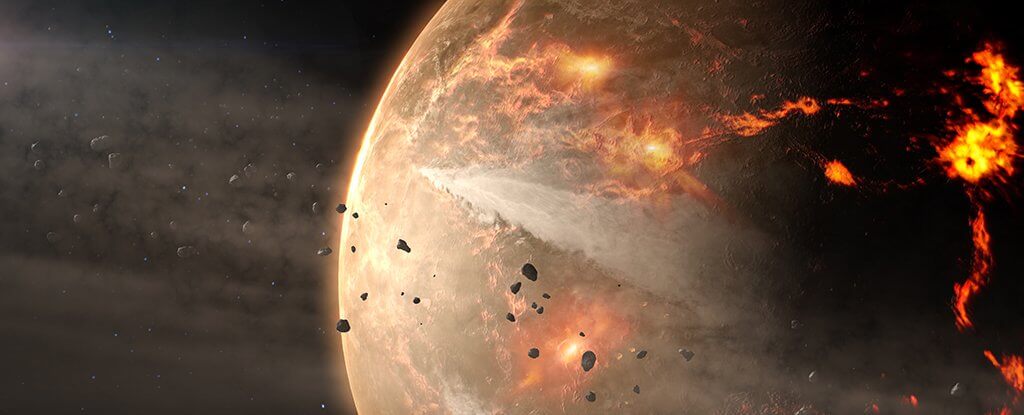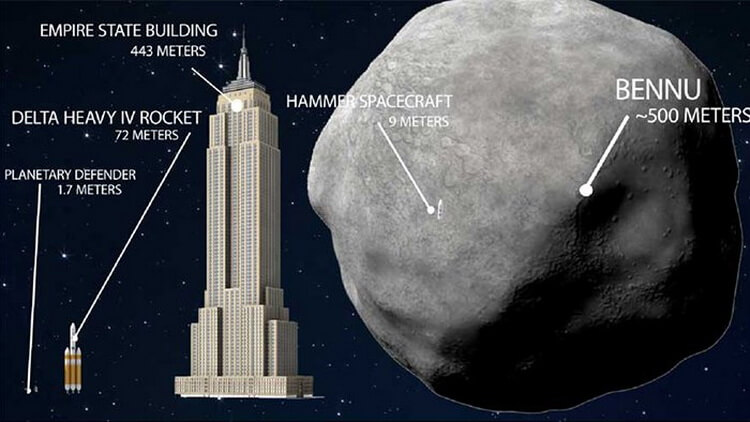- Get link
- X
- Other Apps

Recent calculations by NASA specialists show that with probability 1 to 2,700, a very large asteroid Bennu can crash into the Earth. It should happen in the next century. Experts believe that the consequences of the meeting with Benn can be extremely destructive - up to the complete destruction of life on Earth. Assessing possible risks, scientists came to the conclusion that there is no guarantee of protecting the planet from a collision. According to experts, the currently developed ways to avoid a meeting with an asteroid are not 100% effective. But nevertheless, these developments are under way.
Considering that the explosion power at the moment of an asteroid's collision with the Earth can be about 1200 megatons, which is roughly equivalent to 80 thousand bombs dropped on Hiroshima - it is quite understandable that NASA's desire to "perebdet, rather than not to endure".
According to experts, Bennu's fall to Earth may occur on Sunday, September 25, 2135. Quite recently in the journal Acta Astronautica an article was published in which scientists shared ideas on how to avoid this catastrophic event.
"At the moment, the probability of the fall of the asteroid to Earth is rather weak, but the consequences, in case of this fall, will certainly become catastrophic for our planet," explains Kirsten Hawley from the Livermore National Laboratory and one of the participants in the newly formed NASA planetary security team.
"When it becomes clear to us that the threat of an asteroid's fall is really imminent, we would very much like to see the Earth ready by this time to repel this threat."
The most promising concept of a system of reflecting an asteroid threat is the project of the HAMMER (Hypervelocity Asteroid Mitigation Mission for Emergency Response) spacecraft. The device is proposed to be used either as a carrier of a thermonuclear charge or as a strike device - in fact a ram, with the help of which scientists could push Benn away from a dangerous trajectory.
At the moment, HAMMER - so far only a concept. Presumably it will be a spacecraft weighing about 8 tons and a height of about 9 meters. For comparison: the width of the asteroid Bennu is more than 510 meters. The space rock weighs about 79 million tons, which is approximately 1664 times the weight of the Titanic. The launch of the HAMMER is proposed with the help of the Delta IV Heavy, which is the second largest carrier in the world after Falcon Heavy from SpaceX.

"Two realistic solutions to the situation that are currently under consideration are the use of a spacecraft as a strike element or carrier for the delivery of a nuclear explosive to reject an approaching near-Earth object," the authors of the study report in an article published in the journal Acta Astronautica.
The researchers note that it is extremely important to choose the most optimal moment for launching the spacecraft. If the launch is carried out too early, it will be difficult to predict how the asteroid will behave after the impact. If you run it too late - a giant rock will be difficult to dislodge from the trajectory.
Hawley and her colleagues carried out calculations and found out that for the success of the mission, it would take from 7 to 11 HAMMER launches if 25 years were left before the probable collision. If, however, the collision remains about 10 years, the number of necessary launches may increase to 53.
Scientists note that with each additional launch, not only the chances of failure of each particular launch will increase, but also the possibility of a complete failure of the mission.
"In the event that a lot of launches are required to successfully repel the attack, the success of the mission becomes less optimistic due to the increasing chance of failing each individual launch," says physicist Livermore National Laboratory Megan Brook Seel.
Researchers believe that it is more preferable to use HAMMER in the form of a shock element, which, appearing on the asteroid's path, will be able to push it to the other side and will not allow reaching the Earth. However, due to a number of uncertainties and a small available reaction time, this method may prove ineffective.
In this case, a more appropriate option, according to experts, will be the equipping of the HAMMER spacecraft with a nuclear charge and its subsequent launch towards Bennu. The explosion, according to researchers, will not destroy the asteroid, but it can push it out of the dangerous trajectory of rapprochement with the Earth. At the same time, it is not proposed to undermine the nuclear charge on the asteroid itself (many have probably now thought of the film epic "Armageddon"), but in its immediate vicinity. In this case, one of the sides of the asteroid will undergo the most powerful radiation. Its matter will begin to evaporate, and the gases that escape from its surface will create the necessary cravings for changing direction of Bennu.
Scientists say that there are too many uncertainties and probabilities so that you can talk about a more accurate outcome. In the end, before the possible fall of the asteroid to Earth, we have in reserve more than 100 years. Nevertheless, due to its orbit, Bennu flies around the Earth every six years, so we have the opportunity to track changes in the trajectory of its movement. In addition, the cosmic probe OSIRIS-Rex flies to the asteroid. The purpose of the mission is to approach the space object and take samples of its soil for further study.
To date, astronomers have discovered more than 10,000 potentially dangerous near-Earth objects. Far from each of them can be traced as Bennu, but at the same time almost 2500 of them have similar dimensions. Experts predict that if at least one of them hits the Earth, then for humanity the consequences of this strike will turn out to be globally catastrophic.
According to researchers, to start the process of mass extinction on the planet will be enough space stone in size of 1 kilometer. Recall that dinosaurs had to face the consequences of the fall of the asteroid about 10 kilometers in size.
The impact of an asteroid of any size will become catastrophic if not for the whole planet, then at least for its part. The key factor that will help us avoid this fate is our vigilance.
Experts say that in a scenario with the imminent threat of an asteroid falling to the planet, we can reduce the consequences at least a month before this event. The truth is, in this case, we really need to act in the style of the movie Armageddon, launching a very powerful nuclear charge into the object, which will split the asteroid into many fragments. In this case, the damage will be caused only by those fragments that will overcome the earth's atmosphere and yet fall to the planet.
"Postponing the issue in a long box can be the greatest enemy for the realization of any mission to repel an asteroid threat. That is why there is already a need to launch platforms that will help us cope with this threat in the future, "Hawley said.
The article is based on materials .
- Get link
- X
- Other Apps
Comments
Post a Comment